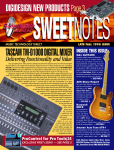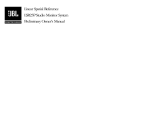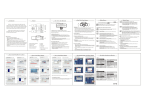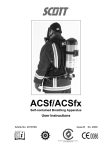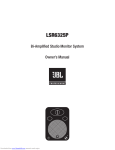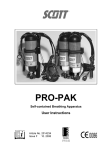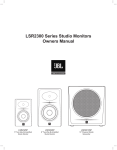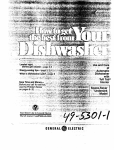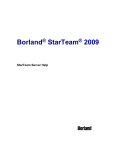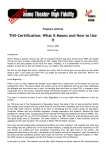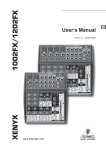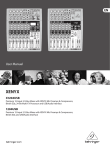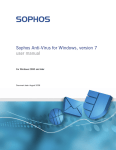Download LSR Manual for pdf
Transcript
LSR Linear Spatial Reference Studio Monitor System Owner’s Manual Important Safety Instructions Explanation of Graphic Symbols The exclamation point within an equilateral triangle is intended to alert the users to the presence of important operating and maintenance (servicing) instructions in the literature accompanying the product. The lightning flash with the arrowhead symbol, within an equilateral triangle, is intended to alert the user to the presence of insulated “dangerous voltage” within the product’s enclosure that may be of sufficient magnitude to constitute a risk of electric shock to humans. CAUTION RISK OF ELECTRIC SHOCK DO NOT OPEN! DO NOT EXPOSE TO RAIN OR MOISTURE! ATTENTION RISQUE DE CHOC ÉLECTRIQUE NE PAS ENLEVER! NE PAS EXPOSER Á LA PLUIE NI Á L'HUMIDITÉ! CAUTION: TO REDUCE THE RISK OF ELECTRIC SHOCK DO NOT REMOVE COVER. NO USER SERVICEABLE PARTS INSIDE. REFER SERVICING TO QUALIFIED PERSONNEL ATTENTION: POUR EVITER LES RISQUES DE CHOC ELECTRIQUE, NE PAS ENLEVER LE COUVERCLE. AUCUN ENTRETIEN DE PIECES INTERIEURES PAR L’USAGER. CONFIER L’ENTRETIEN AU PERSONNEL QUALIFIE. AVIS: POUR EVITER LES RISQUES D’INCENDIE OU D’ELECTROCUTION, N’EXPOSEZ PAS CET ARTICLE A LA PLUIE OU A L’HUMIDITE. The IEC fuse symbol pictured at the left represents an approved, user replaceable fuse. When replacing a fuse, make sure to replace with only the correct type and fuse rating. 1. Read Instructions – Before operating your new JBL LSR product, please read all safety and operating instructions. 2. Keep these instructions – For future reference and troubleshooting purposes, retain these instructions. 3. Heed all warnings – All warnings in this user manual should be followed. 4. Follow Instructions – By following instructions presented in this guide, you should be able to quickly enjoy an accurate and safe monitoring system. 5. Water and Moisture – Do not use this apparatus near water – for example, bathtub, sink or in the shower, regardless of how well you sing. 6. Cleaning – Clean with a lint free cloth-Do not use any solvent based cleaners on the carbon fiber finish. A slightly damp cloth can also be used on the enclosure surfaces and woofer surrounds. 7. Ventilation – Do not block any ventilation opening, including the Linear Dynamics Aperture Port on the LSR monitor systems, by installing these products in accordance with manufacturers instructions. Do not install near any heat sources such as radiators, heat registers, stoves or other apparatus that produce heat. More Safety Instructions 8. Grounding and Power Cords – The power cord supplied with your powered LSR product has a 3-pin type plug. Do not cut off or damage the grounding pin and once again, don’t use in a shower. If the provided plug does not fit into your outlet, consult an electrician for replacement of the obsolete outlet. Protect the power cord from being walked on, or pinched, particularly at plugs, convenience receptacles and the point where they exit the apparatus. All powered LSR products are fitted with a detachable power cord (supplied) which connects to the chassis AC connector. The power cord has an IEC female connector on one end and a male mains connector on the other end. This cord is supplied specifically to accommodate the different safety and electrical code requirements of individual countries. If you are traveling abroad with your system, test the power mains and be aware of any specific voltage requirements before operating your system. 9. Options – Only use attachments or accessories specified by the manufacturer. 10. Non-use Periods – Unplug this apparatus during lightning storms, earthquakes, fires, floods, locusts, or when unused for long periods of time. 11. Servicing – Refer all servicing to qualified service personnel. Servicing is required when the apparatus has been damaged in any way, such as power supply cord or plug is damaged, liquid has been spilled, or objects have fallen into the LSR monitor, the monitor has been exposed to rain or moisture, does not operate normally, exhibits signs of schizophrenia or other psychosis, or has been dropped. 12. Wall or Ceiling Mounting – The appliance should be mounted to a wall or ceiling only as recommended by the manufacturer. 13. Carts and Stands – The appliance should be used only with a cart or stand that is recommended by the manufacturer. An appliance and cart combination should be moved with care. Quick stops, excessive force, and uneven surfaces may cause the appliance and cart combination to overturn. JBL Professional 8500 Balboa Blvd. Northridge, CA 91329 U.S.A Tel: 1 (818) 894-8850 Fax: 1 (818) 830-1220 Web: www.jblpro.com The information contained in this document is confidential and the copyright of JBL Professional. To convey its contents, in part or in whole to any third party without prior written authorization is a violation of the copyright. © JBL Professional 1998. 4 Table of Contents 1.0 Introduction ....................................................................................................................... Page 2 2.0 Getting Started .................................................................................................................... Page 3 2.1 Unpacking....................................................................................................................................... Page 3 2.2 Placement........................................................................................................................................ Page 3 2.3 Audio Connections .......................................................................................................................... Page 4 2.4 AC Power Connections .................................................................................................................... Page 5 2.5 Making Sound Happen ................................................................................................................... Page 5 3.0 LSR32 3-Way Monitor ......................................................................................................... Page 6 3.1 Audio Connections ...........................................................................................................................Page 7 3.2 High Frequency Adjustment ............................................................................................................Page 7 3.3 Changing Mid/High Orientation.....................................................................................................Page 7 4.0 LSR28P 2-Way Bi-Amplified Monitor................................................................................... Page 8 4.1 Audio Connections ...........................................................................................................................Page 8 4.2 AC Power Connections .....................................................................................................................Page 8 4.3 Audio Level Adjustment....................................................................................................................Page 9 4.4 Low Frequency Adjustments ..........................................................................................................Page 10 4.5 High Frequency Adjustments.........................................................................................................Page 10 4.6 LED Indication...............................................................................................................................Page 10 5.0 LSR12P Active Subwoofer.................................................................................................. Page 11 5.1 Audio Connections .........................................................................................................................Page 11 5.2 AC Power Connections ...................................................................................................................Page 12 5.3 Audio Level Adjustment..................................................................................................................Page 12 5.4 Low Frequency Characteristics ......................................................................................................Page 13 5.5 Bypass and Discrete Operation ......................................................................................................Page 13 5.6 LED Indication...............................................................................................................................Page 14 6.0 Specifications.................................................................................................................... Page 15 6.1 LSR32 ............................................................................................................................................ Page 15 6.2 LSR28P .......................................................................................................................................... Page 17 6.3 LSR12P ...........................................................................................................................................Page 19 Appendix A............................................................................................................................... Page 20 1 LSR Studio Monitor Owner’s Manual Section 1. - INTRODUCTION Congratulations on selecting the LSR Linear Spatial Reference Studio Monitors. They represent the sum total of our research and development efforts in sound reproduction. While we don’t expect you to read the entire manual, we do suggest section 2 to get started. At that time, you should have a system to listen to while you intensely study the rest of the manual for maximum performance. Beginning with a blank CAD screen, today’s equivalent to a clean sheet of paper, the LSR products have been based on fundamental research into all aspects of monitor design. JBL designed the entire system starting with the materials and topologies of the individual transducers, through to the final assembly of the diecast parts. The results are incredibly accurate reference systems with high dynamic capabilities and astonishingly low distortion. LSR New Technologies Linear Spatial Reference A measurement and design philosophy that takes into account many additional factors beyond on-axis frequency response. The overall performance of the systems are optimized within a wide listening window for exceptional performance in a variety of acoustic spaces. Attention to these critical aspects results in a rock solid image that remains consistent throughout the entire listening field. Differential Drive® New voice coil and motor assemblies have two drive coils with twice the thermal surface area of traditional speakers. This enables LSR systems to provide higher peak output with less power compression, better heat dissipation and a flatter impedance curve at higher frequencies. These properties reduce spectral shift that causes monitors to sound different when driven at differing power levels. By reducing the thermal related effects, the LSR range will sound the same at low, medium or high levels. Linear Dynamics Aperture™ Contoured ports virtually eliminate high-end turbulence found in traditional port designs. This provides more accurate low frequency performance at higher output levels. Dynamic Braking All LSR low frequency transducers are equipped with an electromagnetic braking voice coil to reduce the effects of extreme excursion with high transient material. Titanium Composite High Frequency Device Using patented technology, the high frequency device incorporates titanium and composite materials to improve transient response and reduce distortion. By reducing distortion in the lower operating range, where the ear is most sensitive, ear fatigue is radically reduced. Elliptical Oblate Spheroidal (EOS) Waveguide Designed for a targeted listening window of +/- 30˚ horizontally and +/- 15˚ vertically, the EOS provides a frequency response through the entire window of 1.5 dB from on-axis. This allows listeners, even far off-axis to hear an accurate representation of the on-axis response. Neodymium Midrange with Kevlar Cone A 2” neodymium motor structure is used in the LSR32 for high excursion capability with an intentionally low crossover point of 250 Hz. This improves the spatial response of the system, which is crucial for accurate reproduction. 2 Section 2. - GETTING STARTED 2.1 Unpacking: When removing the systems from their packaging, it is important not to grasp the units from the front. This is identified as the carbon fiber baffle and can easily be distinguished by the silver stripe. Because the high frequency device is located near the top of the cabinet on the front, a stray hand or finger can cause damage. An easy way to safely unpack your monitors is to open the top of the box, keep the cardboard filler piece on, and roll the box upside down. The box can then be slipped off. This also works in reverse for repacking the units to take them to the next session. 2.2 Placement: The design of the LSR systems lend themselves to a wide variety of placement options. Covered here is a typical stereo setup for near to mid field monitoring. A deeper discussion of multi-channel sound setup is available from JBL in Tech Note Volume 3, Number 3. Listening Distance: By evaluating a broad cross-section of studio environments, it was determined that the common listening position at recording consoles is generally 1 to 1.5 meters (3 to 5 feet) for near field applications. For mid-field applications, 2 to 3 meters is more likely. The real key to successful placement is to form an equilateral triangle between the monitors and the prime listening position. As shown below, the distance between the monitors and the distance between each monitor and the center of the listener’s head are equivalent. 60˚ 60˚ 60˚ Vertical vs. Horizontal Placement: The LSR28P near field is designed to be positioned vertically. This orientation eliminates the phase shifts that occur when the relative distances between the woofer, tweeter and the listening position change. 3 The LSR32 is normally used in the horizontal position. This makes for the lowest elevation to maximize sight lines and reduce shadowing effects of soffit mount monitors. In applications where vertical orientation is desired, the entire mid and high assembly can be rotated 90˚ to a line array position. LSR32L in Horizontal Position LSR32L in Vertical Position The LSR12P can be placed in either a vertical or horizontal orientation. More important than orientation is the physical room placement. As with any low frequency system, subwoofer placement in smaller spaces such as control rooms have a great deal of room interaction. See Section 5 for more information on subwoofer placement and suggested ways to fine tune the monitoring system for optimum performance. Angling towards the listening position: LSR monitors should be angled to directly face the listener. The center of the high frequency transducer should be on-axis with the ear level of the listener. 2.3 Audio Connections: LSR32 Audio Connections: The LSR32 is equipped with two pair of 5-way binding posts. The lower pair feed the woofer and the top pair feed the mid and high frequency elements. The connectors are designed to accept up to 10 AWG bare wire. Spacing of the two input terminal pairs allows use of standard Dual Banana jacks. The two pairs are normally connected together with metal shorting bars. This allows either pair to be used in normal operation. Alternative cabling possibilities include bi-wiring and passive bi-amping or using both terminals to get more “copper” from the amp to the speaker. Positive voltage to the “Red” (+) terminal will produce a forward motion in the low frequency cone. 4 LSR28P Audio Connections: The LSR28P comes with a Neutrik “Combi” connector that accommodates either an XLR or 1/4” connector, in balanced or unbalanced configurations. The XLR input is nominal +4 dBu sensitivity and the 1/4” input is -10 dBv. Additional nominal levels and variable user calibration can also be accommodated. See Section 4 for additional information on level control and gain matching. Positive voltage to Pin 2 of the XLR or the tip of the 1/4” jack will produce a forward motion in the low frequency cone. LSR12P Audio Connections: The LSR12P subwoofer contains both input and output XLR connectors for three channels which are typically Left, Center and Right. The inputs are shipped with a sensitivity of -10 dBv, but can be changed by moving a dip switch on the back of the unit. See Section 5 for additional information on level control and gain matching. The outputs transmit either full range or high passed information, depending on the mode of the subwoofer. An additional discrete input is included that is active when the unit is in L, C, R bypass mode. This allows routing for a separate signal directly to the input electronics of the LSR12P in applications such as 5.1 monitoring. The nominal input is +4 dBu on the direct XLR input connector. Positive voltage to Pin 2 of the XLR will produce a forward motion in the low frequency cone. 2.4 AC Power Connections: The LSR28P and LSR12P have power transformers which allow them to be used with multiple AC supply voltages around the world. Before connecting the unit to AC power, confirm that the switch setting on the rear of the unit is set to the proper position and the fuse is the correct rating. The LSR28P and LSR12P will accept voltages from 100-120 or 200-240 Volts, 50-60 Hz when the voltage setting and fuse is correct. The ground terminal of the IEC plug is required by wiring codes and regulations. It must always be connected to the electrical installation safety ground. The LSR units have carefully designed internal grounding and balanced inputs and outputs to reduce the possibility of ground loops (hum). If hum occurs, see Appendix A for suggested audio signal wiring and system grounding. 2.5 Making Sound Happen: After connections are made, the next step is to power up all equipment before the amplifiers. Reduce the level of the monitor outputs of your console or preamp to minimum and turn on the amplifiers. There is a small delay with the turn on of the LSR28P and LSR12P to accommodate for clicks and thumps from upstream equipment. When the Green LED on the front panel turns on, the units are ready to go. Slowly advance the gain of the console to feed the monitoring system and sit back and enjoy. 5 Section 3. - LSR32 GENERAL OPERATION 3.0 Basic Introduction The LSR32 Linear Spatial Reference Studio Monitor combines JBL’s latest in transducer and system technology with recent breakthroughs in psychoacoustic research to provide a more accurate studio reference. The neodymium 12" woofer is based on JBL’s patented Differential Drive® technology. With the neodymium structure and dual drive coils, power compression is kept to a minimum to reduce spectral shift as power levels increase. An added third coil between the drive coils acts as a dynamic brake to limit excess excursion and reduce audible distortion at the highest levels. The cone is made of a carbon fiber composite forming a rigid piston supported by a soft butyl rubber surround. The midrange is a 2" neodymium magnet structure with a woven 5" Kevlar cone. The powerful motor structure was chosen to support the low crossover point to the woofer. In order to achieve the goal of accurate spatial response, the crossover points are located at 250 Hz and 2.2 kHz. These transition points were chosen to match the directivity characteristics of the three transducers. The high frequency device is a 1" composite diaphragm integrated with an Elliptical Oblate Spheroidal (EOS) Waveguide with 100 x 60 degree dispersion which is critical to the smooth spatial response required in today’s working environments. The Mid and High devices are mounted within millimeters of each other on a cast aluminum sub-baffle that can be rotated for horizontal or vertical placement. This allows maximum flexibility in placement to reduce console and ceiling splash that destabilizes imaging and depth. The crossover filters are optimized to yield 4th-order (24 dB/octave) Linkwitz-Riley electroacoustic responses from each transducer (in phase; -6 dB at crossover). In order to achieve optimal symmetrical response in the vertical plane, both magnitude and phase compensation are implemented in the crossover network. The crossover network allows the user to adjust the high frequency level above 3 kHz. This allows the listener to compensate for effects of near-field or mid-field spectral balance or differing amounts of high frequency absorption. Components used in the crossover are exclusively low-loss metal film capacitors; low distortion electrolytic capacitors; high-Q, high saturation current inductors and high current sand cast power resistors. 3.1 Audio Connections: The LSR32 is equipped with two pair of 5-way binding posts. The lower pair feed the woofer and the top pair feed the mid and high frequency elements. The connectors are designed to accept up to 10 AWG bare wire. Spacing of the two input terminal pairs allows use of standard Dual Banana jacks. The two pairs are normally connected together with metal shorting bars. This allows either pair to be used in normal operation. Alternative cabling possibilities include bi-wiring and passive bi-amping or using both terminals to get more “copper” from the amp to the speaker. Positive voltage to the “Red” (+) terminal will produce a forward motion in the low frequency cone. 6 Use only two conductor insulated and stranded speaker wire, preferably no smaller than 14 AWG. Cable runs exceeding 10 meters (30 feet) should be made with heavier wire, 12 or 10 AWG. 3.2 High Frequency Adjustment: The LSR32 High Frequency level can be adjusted to compensate for placement or “bright” rooms. The unit is shipped in the “flat” or 0 dB position. If the unit sounds too bright in your room, or you are working very close to the monitors (under 1-1.5 meters) the response above 3 kHz can be brought down by approximately 1 dB. This adjustment is accomplished via the barrier strip on the back of the enclosure located above the dual pair of 5-way binding posts. Moving the link between the 0 and -1 dB position will change the high frequency drive level. Please note that the loudspeaker should be disconnected from the amplifier during this procedure for safety of the system and yourself. 0 dB -1 dB 3.3 Rotation of Mid/High Transducers: The LSR32 is normally used in the horizontal position with the mid- and high-frequency elements toward the middle. This provides the lowest elevation, maximizes sight lines and reduces shadowing effects of soffit mount monitors. In situations where vertical orientation is desired, the entire Mid/High sub-baffle can be rotated. NOTE: The mid and high transducers can be easily damaged by wayward screwdrivers. Take great care to protect them as long pointy objects tend to have negative effects on performance which are not covered under warranty. 1. Place the LSR32 on its back on a stable surface. 2. Carefully remove the eight phillips screws surrounding the Mid/High sub-baffle. 3. Gently lift the baffle out enough to rotate the assembly. You can use your hand in the port to assist. Do not pull the unit out entirely. This avoids unnecessary tension on the cabling assemblies. 4. Replace the eight screws and tighten. Again, take note to be VERY careful to guard against transducer damage. 7 Section 4. - LSR28P GENERAL OPERATION 4.0 Introduction: The LSR28P Bi-amplified reference monitor sets a new standard for exceptional performance in a near field design. Using a combination of advanced transducer engineering and powerful drive electronics, the LSR28P will stand up to the most demanding sessions. The 8” woofer is based on JBL’s patented Differential Drive® technology. With dual 1.5” drive coils, power compression is kept to a minimum to reduce spectral shift as power levels increase. An added third coil between the drive coils acts as a dynamic brake to limit excess excursion and reduces audible distortion at maximum levels. The cone is made of a carbon fiber composite forming a rigid piston and is supported by a soft butyl rubber surround. The high frequency device is a 1" composite diaphragm integrated with an Elliptical Oblate Spheroidal (EOS) Waveguide with 100 x 60 degree dispersion which is critical to the smooth spatial response required in today’s working environments. 4.1 Audio Connections: The LSR28P comes with a Neutrik “Combi” connector that accommodates either an XLR or 1/4” connector, in balanced or unbalanced configurations. The XLR input is nominal +4 dBu and the 1/4” is setup as standard for -10 dBv. Positive voltage to Pin 2 of the XLR and the tip of the 1/4” jack will produce a forward motion in the low frequency cone. 4.2 AC Power Connections: 230V 115V The LSR28P has a multi-tap power transformer which allows it to be used around the world. Before connecting the unit to AC power, confirm that the switch setting on the rear of the unit is set to the proper position and the fuse is the correct rating as listed on the rear of the system. The LSR28P will accept voltages from 100-120 or 200-240 Volts, 50-60 Hz when the voltage settings are set correctly. 8 The ground terminal of the IEC plug is required by wiring codes and regulations. It must always be connected to the electrical installation safety ground. The LSR units have carefully designed internal grounding and balanced inputs and outputs to reduce the event of ground loops (hum). If hum occurs, see Appendix A for suggested correct audio signal wiring and system grounding. 4.3 Audio Level Adjustment: The audio level sensitivity of the LSR28P can be adjusted for almost any situation. Monitor outputs on consoles are normally at a nominal level of +4 dBu or -10 dBv. These are typically called professional and semiprofessional, respectively. ON 115V The LSR28P can be set up for fixed or variable gain. As shipped from the factory, the nominal input level of the XLR input is +4 dBu and -10 dBv for the 1/4” T/R/S input. A nominal level to these inputs will produce an output of 96 dB SPL at 1 meter in an anechoic environment. This allows the user to get a good match when using either professional or semiprofessional equipment. If less sensitivity is needed, 4, 8 or 12 dB of signal attenuation can be inserted using the DIP switches on the back. Switch 1 enables the input trim pot. With the switch in the down position, the trim pot is out of the circuit and does not affect the input sensitivity. In the up position, the input trim is added to the circuit and will attenuate the input level from 0 - 12 dB from nominal. Switch 2 inserts 4 dB of attenuation to both the XLR and 1/4” T/R/S inputs when in the up position. Switch 3 inserts 8 dB of attenuation to both the XLR and 1/4” T/R/S inputs when in the up position. 9 4.4 Low Frequency Adjustments: • • • • • • • • +2 0 -2 0 dB/36 dB/36 dB/36 dB/24 dB dB dB dB Octave Octave Octave Octave The low frequency response of the LSR28P can be adjusted to increase or reduce the output level. This is typically done when the system is located near a wall or other boundary surface. With all bass adjustment switches off, the unit is set to a 36 dB/octave roll-off with a maximally flat characteristic. Switch 4 changes the low frequency roll-off to a 24 dB/octave slope, which extends the low frequency capability, while slightly reducing maximum sound pressure level. This is useful for spoting subsonic distortions that could otherwise go undetected. For example, extreme low frequency rumble will be visable as movement of the woofer cone. Switch 5 changes the low frequency roll-off to 36 dB/octave with a 2 dB boost below 150 Hz. If more bass is desirable in the monitor, this is the position to use. In a typical monitor situation, this position could lead to “Bass Light” records as the user compensates in the mixing suite for the extra low end boost. Switch 6 changes the low frequency roll-off to 36 dB/octave with a 2 dB cut below 150 Hz. If required, the LSR28Ps can be used closer to walls or other boundaries. This position reduces the low frequency to compensate for boundary effects caused by this positioning. 4.5 High Frequency Adjustments: Switch 7 On +2 dB Switch 7 & 8 Off Flat Switch 8 On -2 dB Switch 7 boosts the high frequency response by 2 dB above 1.8 kHz. This position is used if the room is extremely dead or mixes translate too bright. Switch 8 cuts the high frequency response by 2 dB above 1.8 kHz. This position is used if the room is highly reflective or mixes translate dull. 4.6 LED Indication: A single LED indicator is located on the front of the LSR28P. In normal operation, this LED will be GREEN. At the onset of amplifier clipping in either the low or high frequency amplifier, the LED will flash RED. Continual RED flashing of this LED indicates that levels should be reduced. 10 Section 5. - LSR12P ACTIVE SUBWOOFER The LSR12P Active Subwoofer consists of a high powered Differential Drive® 12” neodymium woofer integrated with a powerful 250 watt continuous power output amplifier. The active drive circuitry has been developed to maximize the acoustic output power while maintaining overall low distortion and high transient performance. The enclosure is manufactured with a carbon fiber composite baffle and rigidly braced MDF enclosure for low resonance and minimal box lose. The Linear Dynamics Aperture (LDA) Port design minimizes port noise and eliminates bass robbing port compression. Active crossover electronics supply 4th-order electroacoustic slopes to the low pass subwoofer transition to reduce the possibility of localization of the subwoofer. This allows a greater flexibility in placement for optimum operation in a wide variety of rooms. Since low frequency energy supplied by the LSR12P is essentially omnidirectional, placement of the unit(s) is more dependent upon room acoustics and interactions than localization issues. Also included with the active electronics are switchable high pass filters for the front satellite speakers. This option is used when it is desired to filter out low frequency information from the front speakers and redirect this information to the subwoofer. This is usually the case when the front speakers are small near fields that cannot handle extended low frequency information at the desired sound pressure level. Alternatively, if the front channels are operated in full range, the bypass function can be enabled allowing the subwoofer to be muted at the close of a switch contact to compare the different combinations during mixing. 5.1 Audio Connections: There are several ways to connect the LSR12P into a monitoring system including stereo and multichannel formats such as Dolby ProLogic, AC-3, DTS, MPEG and others. The bass management system in the LSR12P provides the flexibility to switch between configurations. In a Stereo Configuration, it is typical to feed the LSR12P with the left and right channels and take the left and right outputs from the LSR12P and feed them to the satellites. The high pass filters on the outputs remove the low frequency energy below 85 Hz from the satellites. This energy is redirected to the subwoofer. The ProLogic format from Dolby uses a similar connection scheme to the one above. The Left, Center and Right channels route to the Left, Center and Right inputs of the LSR12P and through the respective outputs to the satellites. Energy below 85 Hz is filtered out of the satellites and sent to the subwoofer. Other multichannel formats such as Dolby AC-3, DTS, MPEGII include six discrete channels, Left, Center, Right, Left Surround, Right Surround and Subwoofer. These are termed 5.1 for five main channels and a dedicated subwoofer channel, which is also called the Low Frequency Effects or LFE channel. Not all material uses all channels and engineers have the discretion to use the subwoofer. 11 The Left, Center and Right channels are routed to the respective LSR12P inputs and on to the front channels. The .1 feed is sent directly to the discrete input of the LSR12P. When not in bypass, the system operates as the Stereo and Prologic setups previously described. All subwoofer information is derived from the front channels and the discrete .1 input is ignored. When a contact closure occurs, the high pass filtering is bypassed to the satellites and the subwoofer feed is from the discrete .1 input. Additional information is contained in section 5.5. 5.2 AC Power Connections: 230V 115V The LSR12P has a multi-tap transformer which allows it to be used around the world. Before connecting the unit to AC power, confirm that the switch setting on the rear of the unit is set to the proper position and the fuse is the correct rating as listed on the rear of the system. The LSR12P will accept voltages from 100-120 or 200-240 Volts, 50-60 Hz when the voltage settings are set correctly. The ground terminal of the IEC plug is required by wiring codes and regulations. It must always be connected to the electrical installation safety ground. The LSR units have carefully designed internal grounding and balanced inputs and outputs to reduce the event of ground loops (hum). If hum occurs, see Appendix A for suggested correct audio signal wiring and system grounding. 5.3 Changing Audio Levels: Switch 1 enables the input trim pot. With the switch in the down position, the trim pot is out of the circuit and does not affect the input sensitivity. In the up position, the input trim is added to the circuit and will attenuate the input level from 0-12 dB. Switch 2 changes the nominal sensitivity of the LSR12P Left, Center and Right inputs to +4 dBu. Switch 3 changes the nominal sensitivity of the LSR12P Left, Center and Right inputs to +8 dBu. 12 115V ON 5.4 Changing Low Frequency Characteristics: Switch 4 reverses the polarity of the LSR12P. At the crossover point between the subwoofer and satellite speakers, it is important that all systems are in the correct polarity. If the subwoofer and the satellite woofers are in the same vertical plane, the polarity should be set to normal. If the subwoofer is not in the same plane as the satellites, the polarity might need to be reversed. To check this, put on a track that has a good amount of bass and switch between the two positions. The setting that produces the most bass should be the one to go with. The low frequency response of the LSR12P can be adjusted to compensate for room placement. Bass frequencies below 80-90 Hz are essentially omnidirectional. Positioning subwoofers in corners or against walls will increase the in-room efficiency of the system allowing greater apparent output. Placing subwoofers against wall boundaries will also reduce frequency response variations due to cancellation interference. These bass adjustment switches compensate for location by adjusting the amount of low frequency energy generated below 50 Hz. A technique that has been used successfully is to put the subwoofer in the listening position and move the mic or yourself into possible subwoofer locations. Finding the positions with the best low frequency energy can quickly be found. After you find a couple of possibilities, move the subwoofer into one of these locations and evaluate. Switch 5 reduces the level below 50 Hz by 2 dB. This position is designed to offer maximally flat response when the LSR12P is placed at the intersection of two boundaries such as a floor and wall. Switch 6 reduces the level below 50 Hz by 4 dB. This position has been designed to offer maximally flat response when the LSR12P is placed at the intersection of three boundaries such as a corner location. 5.5 Bypass and Discrete Operation: The 1/4” jack used for bypass and discrete selection operates with a simple dry contact closure between the tip and sleeve of the jack. This function can also be initiated with an opto-isolated electronic closure shorting the two contacts together. The sleeve of this connector is tied to audio ground so care should be taken to avoid ground loops when using this option. 13 5.6 LED Indication: A multicolor LED indicator is located on the front of the LSR12P. In normal operation, this LED will be GREEN. When the LSR12P is in bypass mode, the LED will turn AMBER. This indicates that the high pass filters on the three outputs are bypassed and the subwoofer feed is from the discrete input. At the onset of amplifier limiting the LED will flash RED. Continual RED flashing of this LED indicates that the levels should be reduced. 14 Section 6. - LSR32 SPECIFICATIONS Amplitude & Phase System: Input Impedance (nominal): 4 ohm Anechoic Sensitivity:1 93 dB/2.83V/1m (90 dB/1W/1m) Frequency Response (60 Hz - 22 kHz)2: +1, -1.5 Low Frequency Extension2 -3 dB: 54 Hz -10 dB: 35 Hz Enclosure resonance frequency: 28 Hz Long Term Maximum Power (IEC 265-5): 200 W Continuous; 800 W Peak Recommended Amplifier Power: 150 W - 1000 W (rating into 4 ohm load) HF Frequency Control (2.5 kHz - 20 kHz): 0 dB, -1 dB Distortion, 96 dB SPL, 1m:3 Low Frequency (below 120 Hz): 2nd harmonic: < 1.5% 3rd harmonic: < 1 % Mid & High Frequency (120 Hz - 20 kHz): 2nd harmonic < 0.5% 3rd harmonic < 0.4% Distortion, 102 dB SPL, 1m:3 Low Frequency (below 120 Hz): 2nd harmonic: < 1.5% 3rd harmonic: < 1% Mid & High Frequency (80 Hz - 20 kHz): 2nd harmonic: < 1 % 3rd harmonic: < 1 % (N.B: < 0.4%, 250 Hz - 20 kHz) Power Non-Linearity (20 Hz - 20 kHz): 30 watts < 0.4 dB 100 watts: < 1.0 dB Crossover: Frequencies 250 Hz and 2.2 kHz Transducers: Low Frequency Model: 252G Diameter: 300 mm (12 in.) Voice Coil: 50 mm (2 in.) Differential Drive with Dynamic Braking Coil Magnet Type: Neodymium Cone Type: Carbon Fiber Composite Impedance: 4 ohm Mid Frequency Model: C500G Diameter: 125 mm (5 in.) Voice Coil: 50 mm (2 in.) Aluminum Edge Wound Magnet Type: Neodymium Cone Type: KevlarTM Composite Impedance: 4 ohm High Frequency Model: 053ti Diameter: 25 mm (1 in.) diaphragm Voice Coil: 25 mm (1 in.) Magnet Type: Ceramic 5 Diaphragm Type: Damped Titanium Composite Other Features: Elliptical Oblate Spheroidal Waveguide Impedance: 4 ohm Physical: Finish: Black, Low-Gloss, “Sand Texture” Enclosure Volume (net): 50 liter (1.8 cu. ft.) Input Connectors: Two pair of 5-way binding posts. Net Weight: 21.3 kg (47 lbs) Dimensions (WxHxD): 63.5 x 39.4 x 29.2 cm (25.0 x 15.5 x 11.5 in.) 96 dB/1 m (Distortion raised 20 dB) 102 dB/1 m (Distortion raised 20 dB) Notes: All measurements unless otherwise stated made anechoically at 2 meters and referenced to 1 meter by the inverse square law. The reference measurement microphone position is located perpendicular to the centerline of the mid and high frequency transducers, at the point 55 mm (2.2 in.) below the center of the tweeter diaphragm. 1 Mean SPL level from 100 Hz to 20 kHz. 2 Describes Anechoic (4p) low frequency response. Acoustic Loading provided by the listening room will increase low frequency bass extension. 3 Distortion measurements performed with the input voltage necessary to produce the stated “A” weighted SPL level at the stated measurement distance. Distortion figures refer to the maximum distortion measured in any 1/10th octave wide band in the stated frequency range. 4 Power Non-Linearity figures based on the “A” weighted deviation from linear increase in SPL with linear increase in input power (ie: power compression) measured after 3 minutes of continuous pink noise excitation at the stated power level. JBL continually engages in research related to produce improvement. New materials, production methods, and design refinements are introduced into existing products without notice as a routine expression of that philosophy. For this reason, any current JBL product may differ in some respect from its published description, but will always equal or exceed the original design specifications unless otherwise stated. 15 Acoustic Contribution System Impedance Impulse Response Power Compression 1 – 10 WATTS 2 – 30 WATTS 3 – 100 WATTS LSR32 Response Curves 1. On-Axis Response 2. Spatially Averaged Response over a range of +/- 30° Horizontal & +/- 15° Vertical 3. First Reflection Sound Power 4. Total Radiated Sound Power 5. DI of On-Axis Response 6. DI of First Reflections 16 LSR28P SPECIFICATIONS System: Frequency Response (+1, -1.5 dB)2: Low Frequency Extension: -3 dB: -10 dB: Enclosure resonance frequency: Low - High Frequency Crossover: Distortion, 96 dB SPL, 1m: Mid-High Frequency (120 Hz - 20 kHz): 2nd Harmonic: 3rd Harmonic: Low Frequency (<120 Hz): 2nd Harmonic: 3rd Harmonic: Maximum SPL (80 Hz - 20 kHz) : Maximum Peak SPL (80 Hz - 20 kHz): Signal Input: Amplitude and Phase 50 Hz - 20 kHz User controls set to default 46 Hz 36 Hz 38 Hz 1.7 kHz (6th-Order Acoustic Linkwitz-Riley) <0.6% <0.5% <2% <1% >108 dB SPL / 1m >111 dB SPL / 1m XLR, Balanced Pin 2 Hot 1/4” Tip-Ring-Sleeve, Balanced Calibrated Input Sensitivity: XLR, +4 dBu: 96 dB/1m 1/4”, -10 dBV: 96 dB/1m AC Input Voltage: 115/230VAC, 50/60 Hz (User Selectable) AC Input Voltage Operating Range: +/- 15% AC Input Connector: IEC Long Term Maximum System Power: 220 Watts (IEC265-5) Self Generated Noise Level: <10 dBA SPL/1m User Controls: High Frequency Control (2 Khz - 20 kHz):+2 dB, 0 dB, -2 dB Low Frequency Control (<100 Hz) +2 dB, 0 dB, -2 dB Low Frequency Alignments: 36 dB/octave, 24 dB/octave Calibrated Input Attenuation: 5 dB, 10 dB Variable Input Attenuation: 0 - 12 dB Transducers: Low Frequency Model: 218F Diameter: 203 mm (8 in.) Voice Coil: 38 mm (1.5 in.) Differential Drive with Dynamic Braking Coil Magnet Type: Ferrite with Integral Heat Sink Cone Type: Carbon Fiber Composite Impedance: 2 ohm High Frequency Model: 053ti Diameter: 25 mm (1 in.) diaphragm Voice Coil: 25 mm (1 in.) Magnet Type: Ferrite Diaphragm Type: Damped Titanium Composite Other Features: Elliptical Oblate Spheroidal Waveguide Impedance: 4 ohm Amplifier: Low Frequency Topology: Class A-B, All Discrete Sine Wave Power Rating: 250 Watts (<0.1% THD into rated impedance) THD+N, 1/2 power: <0.05% High Frequency Topology: Class A-B, Monolithic Sine Wave Power Rating: 120 Watts (<0.1% THD into rated impedance) THD+N, 1/2 power: <0.05% Physical: Finish: Black, Low-Gloss, “Sand Texture” Enclosure Volume (net): 50 liter (1.0 cu. ft.) Low Frequency Vent: Rear Ported Linear Dynamics Aperture Baffle Construction: Carbon Fiber Composite Cabinet Construction: 19mm (3/4” M.D.F.) Net Weight: 22.7 kg (50 lbs) Dimensions (WxHxD): 406 x 330 x 325 mm (16 x 13 x 12.75 in.) 96 dB/1 m (Distortion raised 20 dB) 102 dB/1 m (Distortion raised 20 dB) Notes: All measurements unless otherwise stated made anechoically in a 4π environment at 2 meters and referenced to 1 meter by the inverse square law. The reference measurement microphone position is located perpendicular to the centerline of the low and high frequency transducers, at the point 55 mm (2.2 in.) below the center of the tweeter diaphragm. The Reference Measurement Microphone position is located perpendicular to the upper edge of the center of woofer trim ring. Acoustic loading provided by the listening room increases Maximum SPL capabilities and Low Frequency Bass Extension as compared to stated anechoic values. Distortion measurements performed with the input voltage necessary to produce the stated “A” weighted SPL level at the stated measurement distance. Distortion figures refer to the maximum distortion measured in any 1/10th octave wide band in the stated frequency range. JBL continually engages in research related to produce improvement. New materials, production methods, and design refinements are introduced into existing products without notice as a routine expression of that philosophy. For this reason, any current JBL product may differ in some respect from its published description, but will always equal or exceed the original design specifications unless otherwise stated. 17 Impulse Response Acoustic Contribution LSR28P Response Curves 1. On-Axis Response 2. Spatially Averaged Response over a range of +/- 30° Horizontal & +/- 15° Vertical 3. First Reflection Sound Power 4. Total Radiated Sound Power 5. DI of On-Axis Response 6. DI of First Reflections 18 LSR12P SPECIFICATIONS Amplitude contribution with LSR12P and 28P Specifications: System: Frequency Response (-6 dB) : Low Frequency Extension: -3 dB: - 10 dB: Enclosure resonance frequency: Low - High Frequency Crossover: Distortion, 96 dB SPL / 1m: Low Frequency (< 80 Hz): 2nd Harmonic: 3rd Harmonic: Maximum Continuous SPL: Maximum Peak SPL: Calibrated Input Sensitivity: XLR, +4 dBu: XLR, -10 dBV: Power Non-Linearity (20 Hz - 200 Hz): 30 watts 100 watts: Power/Clip/Bypass Indications: 28 Hz - 80 Hz1 User controls set to default 34 Hz 26 Hz 28 Hz 80 Hz (4th order electroacoustic Linkwitz-Riley) <2% <1% >112 dB SPL / 1m(35 Hz - 80 Hz) >115 dB SPL / 1m (35 Hz - 80 Hz) 96 dB/1 m (Distortion raised 20 dB) 96 dB/1m 96 dB/1m < 0.4 dB < 1.0 dB Green LED - Normal Operation Amber LED - Bypass Mode Red LED - Limiter Activated Amplifier: Low Frequency Topology: Sine Wave Power Rating: THD+N, 1/2 power: AC Input Voltage: AC Input Voltage Operating Range: AC Input Connector: Self Generated Noise Level: Transducers: Low Frequency Model: Diameter: Voice Coil: Class A-B, All Discrete 260 Watts (<0.5% THD into rated impedance) <0.05% 115/230VAC, 50/60 Hz (User Selectable) +/- 15% IEC <10 dBA SPL/1m Low Frequency Adjustments Flat -2 dB -4 dB 252F 300 mm (12 in.) 50 mm (2 in.) Differential Drive with Dynamic Braking Coil Magnet Type: Neodymium with integral heatsink Cone Type: Carbon Fiber Composite Impedance: 2 ohm User Controls: Low Frequency Control (< 50 Hz) Left, Center and Right Inputs: Discrete Input: Calibrated Input Level1: Variable Input Attenuation1: Left, Center and Right Outputs: Output High Pass Filters2: Polarity Adjustment: Remote Bypass Connector: +2 dB, 0 dB, -2 dB XLR Balanced (-10 dBv/+4 dBu Nominal, Pin 2 Hot) XLR Balanced (+4 dBu Nominal, Pin 2 Hot) -10 dBv, +4 dBu, +8 dBu 0 - 13 dB XLR Balanced (-10 dBv/+4 dBu Nominal, Pin 2 Hot) 80 Hz 2nd Order Bessel (Selectable to Full Range) Normal or Inverted 1/4” Tip/Sleeve Jack Physical: Finish: Baffle Material: Enclosure Volume (net): Net Weight: Dimensions (WxHxD): Black, Low-Gloss, “Sand Texture” Carbon Fiber Composite 50 liter (1.8 cu. ft.) 22.7 kg (50 lbs) 63.5 x 39.4 x 29.2 cm (25.0 x 15.5 x 11.5 in.) Notes: Left, Center and Right Inputs Produces Quasi-fourth order Linkwitz-Riley Acoustic High pass alignment when used with LSR28P or LSR32. 1 2 All measurements unless otherwise stated made anechoically in a 4π environment at 2 meters and referenced to 1 meter by the inverse square law. The reference measurement microphone position is located perpendicular to the upper edge of the center of woofer trim ring. Acoustic Loading provided by the listening room will increase maximum SPL capabilities and low frequency bass extension as compared to stated anechoic values. Distortion measurements performed with the input voltage necessary to produce the stated “A” weighted SPL level at the stated measurement distance. Distortion figures refer to the maximum distortion measured in any 1/10th octave wide band in the stated frequency range. JBL continually engages in research related to produce improvement. New materials, production methods, and design refinements are introduced into existing products without notice as a routine expression of that philosophy. For this reason, any current JBL product may differ in some respect from its published description, but will always equal or exceed the original design specifications unless otherwise stated. 19 Appendix A: Wiring Recommendations By now, you have probably plugged the LSR monitors in and are making great music. However, for optimum performance, some attention to wiring details now can reduce system degradation later. These cabling recommendations follow standard wiring practice for differential inputs. Balanced Sources The best way to run your system is balanced, where both “HOT” (+) and “COLD” (-) signals are supplied from the source as well as a GROUND/SHIELD. These are typically carried on 2 conductor shielded cables with XLR connectors on both ends. Alternatively, connectors with Tip, Ring and Sleeve (T/R/S) jacks can be used. Whenever possible, the cable shield should not be connected to any signal pin, but left to perform a cable shielding function only. Note: Under no circumstances should the safety ground wire be removed from the AC power connector. When using balanced sources with the LSR28P, either the XLR or T/R/S input of the Neutrik “Combi” connector can be used. The difference between the two is that the T/R/S is set for a nominal -10 dBv input and the XLR is set for +4 dBu. Balanced Source LSR Input + Pin 2 (Tip) Pin 2 (Tip) + - Pin 3 Pin 3 (Ring) (Ring) - Pin 1 Pin 1 (Sleeve) (Sleeve) Balanced Diagram A For balanced signals, the HOT (+) signal from your source should be connected to the tip of the T/R/S connector or Pin 2 of the XLR input as shown in figure A. The “COLD” (-) signal should be connected to Pin 3 of the XLR or the “Ring” of the T/R/S connector. To avoid ground loops, connect the SHIELD at the source end but not at the LSR input. Note: The LSR12P uses only XLR inputs and outputs. Unbalanced Sources When using unbalanced sources, there are more possibilities to introduce ground loops into a system. The LSR28P and 12P offer several ways to help alleviate potential problems with unbalanced equipment. 20 While there are only HOT and GROUND/SHIELD connections from unbalanced sources, it is recommended that high quality twisted pair cable be used. Figure B shows an unbalanced source connected to the balanced XLR input of the LSR monitor using twisted pair cable. Note that the shield is connected to the GROUND/SHIELD connector at the LSR input, but not at the source. This reduces the likelihood of introducing a ground loop into the system. Unbalanced Source + LSR XLR Input Tip Sleeve Pin 2 + Pin 3 - Pin 1 Unbalanced Diagram B When using unbalanced signals with an LSR28P, it is recommended to use a 1/4” Tip/Ring/Sleeve connector. This input has been specifically designed to accommodate a wide variety of balanced and unbalanced connections. Figure C shows when using the 1/4” Tip/Ring/Sleeve connection, the GROUND should be tied to the source and not the sleeve of the LSR input for optimum performance. Unbalanced Source + LSR28P T/R/S Input Tip Sleeve Tip + Ring - Sleeve Unbalanced Diagram C Figure D details the connections using single conductor shielded cable with a Tip/Ring/Sleeve plug for the LSR28P input. Single conductor cable should be used as a last resort as it provides the most possibility for problems. The “HOT” (+) signal should be connected to the tip of the Tip/Ring/Sleeve plug. The GROUND should be attached to the Ring of the Tip/Ring/Sleeve plug at the LSR28P input. Unbalanced Source + LSR Input Tip Pin 2 (Tip) + Pin 3 (Ring) - Pin 1 Sleeve (Sleeve) Unbalanced Diagram D 21 Figure E details the connections using unbalanced cable and Tip/Sleeve connections to the 1/4” input. In this mode, the Ring and Sleeve of the LSR input are shorted by the plug automatically. Unbalanced Source + LSR T/R/S Input Tip Tip + Ring - Sleeve Sleeve Unbalanced Tip/Sleeve Connectors short the Ring and Sleeve Automatically Unbalanced Figure E 22 23 JBL Professional 8500 Balboa Boulevard, P.O. Box 2200 Northridge, California 91329 U.S.A. A Harman International Company LSR MANUAL CRP 1M 8/98 24



























